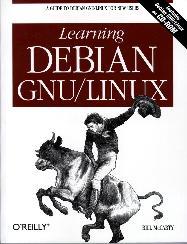
This book contains a goodly amount of information, and not all of it is for the newbie.

Author: Bill McCarty
Publisher: O'Reilly & Associates
E-mail: info@ora.com
URL: http://www.ora.com/
Price: $34.95 US
ISBN: 1-56592-705-2
Reviewer: Marjorie Richardson
Like most O'Reilly books, Learning Debian GNU/Linux is well-organized and well-written. The author, Bill McCarty, is an associate professor of computer science and obviously knows his stuff. The layout is well-done, and not filled with cutesy graphics to distract the eye.
Many books geared for the Linux newbie have come out in the past year—most of them try to stay vendor-neutral. This book follows the recent trend of focusing on one distribution, in this case, Debian. I actually like this trend, as many newbies are confused when presented with variations in the different distributions, so sticking to one should make discussion clearer and shorten the learning curve for some. Also, Debian is not the easiest of distributions to install and use, so a book devoted to it is deserved.
This book contains a goodly amount of information, and not all of it is for the newbie. It is truly a guide to the entire system, not just an introduction. While introductory material such as a history of Linux, installing, configuring, definitions, etc. is presented, much more complex operations, such as setting up both a local (LAN) and a wide-area (WAN) network, are also described.
The material is presented in a straightforward manner, using clear, easy-to-understand language. However, I did feel the book was written with the computer-literate reader in mind. Even though he defines basics such as “what is an operating system”, it still reads as if he expects you to already know. Indeed, he tells you how to get information you will need to install Linux by using your MS Windows menus.
Mr. McCarty devotes entire chapters to user administration and X configuration, as well as networking. His desktop of choice is GNOME, and it too receives a chapter. Also included are chapters on games and connecting to the Internet. The appendices include a Linux directory tree, the principal Linux files, Debian utilities and a Linux Command Quick Reference. A CD-ROM containing the Debian 2.1 distribution is bound into the book.
The book is not without its faults. One amusing mishap is in Chapter 4. An introduction to useful Linux programs states that you will learn the simple text editor pico, then the author proceeds to teach you the simple text editor ae. Guess he changed his mind.
Overall, Learning Debian GNU/Linux is a complete reference guide to this distribution, and well worth adding to your collection of Linux books.